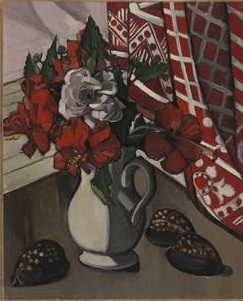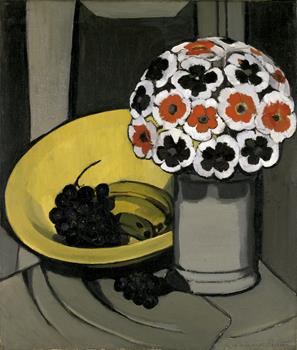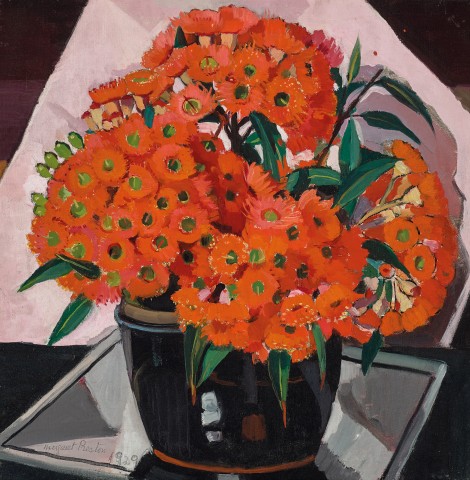COASTAL GUMS, also known as AUSTRALIAN GUM BLOSSOM, 1929
MARGARET PRESTON
oil on canvas
46.5 x 46.0 cm
signed and dated lower left: Margaret Preston/ 1929
inscribed with title on stretcher bar verso: australian gum blossom
Lady Stevenson, United Kingdom
Thence by descent
Doris Zinkeisen, United Kingdom
Lord Alastair McAlpine, Western Australia, acquired from the above in 1991
The Bishop House Collection, Phillips Auctioneers, Sydney, 12 August 1999, lot 460
Private collection, Melbourne
Deutscher~Menzies, Melbourne, 3 May 2000, lot 61 (as ‘Australian Gum Blossoms’)
The Cbus Collection of Australian Art, Melbourne, acquired from the above
Margaret Preston, Grosvenor Galleries, Sydney, 7 – 31 August 1929, cat. 27
A Selection of Important 20th Century Australian and New Zealand Paintings, Martin Browne Fine Art, Sydney, 6 – 31 October 1999 (illus. in exhibition catalogue, n.p.)
Colour and Movement, Benalla Art Gallery, Victoria, 19 February – 9 June 2016
on long term loan to Geelong Art Gallery, Victoria
Butler, R., The Prints of Margaret Preston: A Catalogue Raisonné, National Gallery of Australia, Canberra, 1987, p. 311
Margaret Preston Catalogue Raisonné of paintings, monotypes and ceramics, Art Gallery of New South Wales, Sydney, 2005, CD–ROM compiled by Mimmocchi, D., with Edwards, D., and Peel, R., cat.1929.33
Nainby, B., Stanhope, Z., and Furlonger, K., The Cbus Collection of Australian Art, in association with Latrobe Regional Gallery, Melbourne, 2009, pp. 12 (illus.), 15, 54 (illus.), 230
46025 - Super Hi-Res Unclipped (TIFF 4200px).jpg

In 1926, Margaret Preston was chosen for a special edition of Art in Australia dedicated to her art and ideas, only the second local artist to be so honoured.1 The Editorial provocatively declared that ‘(a)ll vital artists have enemies. Where they fail to inspire delight they instil terror. Margaret Preston is the natural enemy of the dull.’ Appreciative articles by Professor Alfred Radcliffe-Brown and Thea Proctor were also included, with the former noting that her work, like all notable modern painting, ‘seeks a design which is and appears constructed.’2 Proctor went further, claiming her colleague to be ‘a distinguished and original artist … with abundant vitality, unerring taste in selection, the intellectual gift of invention and an emotional colour sense which amounts to genius.’3 Preston was quickly becoming the most prominent voice for modernist art in Australia through her teaching and by her increasingly stimulating essays, the first of which had appeared in The home magazine in 1923 where she asked – and then answered – the question, ‘When is a work modern? When it represents the age it is painted in.’4 Two years later in Art in Australia, she provided a cover illustration and an accompanying illustrated essay detailing what she saw as the decorative design possibilities of Indigenous art.5 Ultimately, Preston contributed twenty-seven articles to Art in Australia and The home, as well as writing for other publications, paving the way for a generation of local modernist artists.
Originally hailing from Adelaide, she undertook training at the National Gallery School in Melbourne from 1893, subsequently studying at academies in Germany and Paris, with her thorough understanding of Japanese print techniques further enhancing her world view. In late 1927, she travelled through parts of Indigenous Australia and the inspirations she discovered there came together powerfully in her paintings and wood-block prints from then on. Her stated ambition was to find a truly national art for this country that fused elements of European, Asian and, particularly, Indigenous art without which, she believed, the local variant of modernism would remain a pale imitation of overseas influence. Key works from 1927, such as Implement blue (Art Gallery of New South Wales), Still life (location unknown), and Banksia (National Gallery of Australia), as well as Aboriginal flowers, 1928 (Art Gallery of South Australia), all feature the pronounced ‘machine-cubist’ influence of Fernand Léger, with native flowers and domestic implements arranged against deliberately angled and flattened backgrounds. It is a vital and forward-looking collection of imagery that divided local audiences; conversely, they are all now recognised as masterworks in Australian art history.
HIGH RES TIFF MARGARET PRESTON.jpg

In early 1929, Preston arranged to have her first solo exhibition of paintings and woodcuts at the new Grosvenor Galleries in Sydney, and demonstrated both her commitment and discipline by working ‘from nine to five for eight months’ in the lead-up.6 She was known for her aphorisms (‘pithy statements’), one of which was ‘Why there are so many tables of still life in modern paintings is because they are really laboratory tables on which aesthetic problems can be solved.’7 With this comment in mind, the diversity of settings, blooms and arrangements in the exhibition was truly staggering. Some, such as this lot, Coastal gums, 1929, extended her forensic study of angular backgrounds as seen in the earlier ‘machine-cubist’ paintings, whilst other of the still-lifes were set on tablecloths against brick walls, offset by domestic objects, some including glimpses of landscape outside the adjacent windows. The list of prominent buyers included the Governor’s wife, Lady Edith de Chair (who also opened the show), and the noted obstetrician and gynaecologist Dr Constance D’Arcy, as well as Preston’s artworld colleagues Adrian Feint and Basil Burdett. Yet despite such support, local newspaper critics remained unmoved and, in most cases, confused.
In Coastal gums, the blooms belong to Corymbia ficifolia, a tree native to a small area of south-coastal Western Australia, but which is now one of the most widely planted around the world in tropical and sub-tropical zones. Apart from its aesthetic qualities, Preston’s arrangement highlights her allied interest in pure mathematics through her ‘meticulous detailing of the complex and mathematically precise patterns of growth.’8 Standing in a ceramic vase possibly made by her close friend Glady Reynell, the vibrant pink-red blossoms radiate in a continuous orbit from higher to lower, counterbalanced by the sharp angle of the mirrored tray and the triangular void behind them, both executed in stark black-and-white. Small details such as the black outline to the flowers in the highest bunch and that to the lower right, the contrasting green of the buds, and the warm violet tonal areas all add evidence to the attention she paid to the composition. There is nothing extraneous or haphazard, and seen as a whole, this painting underscore’s Professor Radcliffe-Brown’s earlier observation that Coastal gums is a ‘constructed’, modern image – emphatically not a passive one.
1. Art in Australia, Ure Smith, Sydney, 3rd series no.22, 1 December 1926. The previous artist was Hans Heysen
2. Radcliffe-Brown, A., ‘Margaret Preston and transition’, in Art in Australia, ibid., n.p.
3. Proctor, T., ‘An artist’s appreciation of Margaret Preston’, in Art in Australia, ibid.
4. Preston, M., 'Why I became a convert to modern art’, The home, Ure Smith, Sydney, vol. 4, no. 2, 1 June 1923, p. 20
5. Preston, M., ‘The Indigenous art of Australia’, Art in Australia, Ure Smith, Sydney 3rd series, no. 11, 1 March 1925, n.p.
6. North, I., et al., The art of Margaret Preston, Art Gallery of South Australia, Adelaide, 1980, p. 64
7. ‘Aphorism 46’, in Gellert, L., and Ure Smith, S., (eds.), Margaret Preston: recent paintings 1929, Art in Australia, Sydney, 1929, n.p.
8. Edwards, D., Mimmocchi, D., and Peel, R., Margaret Preston, Art Gallery of New South Wales, Sydney, 2005, p. 127
ANDREW GAYNOR
